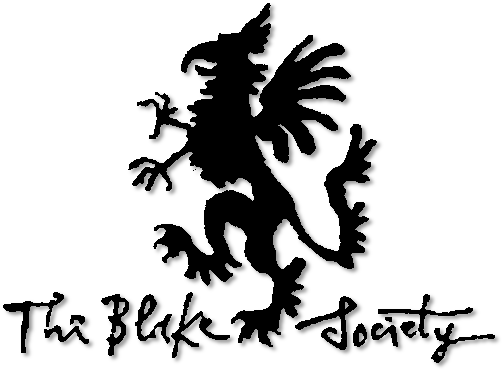Feminist representations in contemporary art
I've been thinking about feminism a lot lately. Three reasons: my current area of academic research concerns Christian Women's Organisations in Africa, which are truly fascinating in themselves, as well as giving me joyful cause to type up notes in bold about 'RECLAIMING THE FEMALE GENITALS: GHANA' in the Manuscripts Room of the UL, for all neighbouring portly men in tweed to enjoy; my recent graduation from the role of Women's Welfare Officer here at Downing, and finally, my constant replaying of Beyoncé's eponymous fifth album, which made its début at the end of last year.
As awe-inspiring -and indeed, controversial- as Queen Bey and her latest musical offering remain, I decided more constructive and intellectually challenging research was needed into the female condition, today in the form of examining representations of women and feminism in the world of modern art, and wanted to share a few of my findings and musings with y'all.
As awe-inspiring -and indeed, controversial- as Queen Bey and her latest musical offering remain, I decided more constructive and intellectually challenging research was needed into the female condition, today in the form of examining representations of women and feminism in the world of modern art, and wanted to share a few of my findings and musings with y'all.
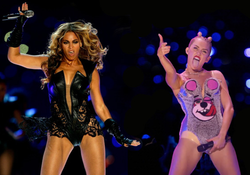
Miley vs. Bey: has today's media failed the female gender? Can we better represent women through contemporary art?
The first artist I came across was Judy Chicago and her 1979 mixed media installation entitled 'The Dinner Party', pictured below. The piece includes several large banquet tables, with 39 place settings for historical and mythical women, celebrating their achievements. There are individual flower-like sculptures on each plate, symbolizing the vulva, and 999 (!!) names of other important women are inscribed amongst the installation.
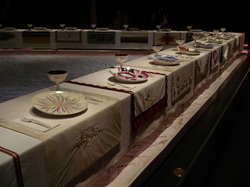
'The Dinner Party'. Photo credit: (http://www.flickr.com/photos/joethelion/2512114583/)
I really enjoy Chicago's work as it promotes a sense of dialogue between women, an imaged conversation had over dinner between influential women across the ages, each a respected member of the discussion with their own place at the table. By viewing the installation as a woman, there is a sense of further participation, an ongoing encounter between women: famous, ordinary, influential, participant or bystander.
The next artist I discovered was Nancy Spero, who created an incredible collage work entitled 'Torture of Women'. It is a 125 foot long scroll (!!) with 14 panels, of which a portion is shown below. It combines both text and images, specifically first-person testimonies taken from Amnesty International reports about missing or deceased women, and definitions of torture.
This struck a chord with my current theological research, notably that concerning Female Genital Mutilation (FGM), a very current issue often considered to constitute violent torture by its critics, victims and onlookers. Additionally, the sheer scale of the work and the effort Spero has put into her work astounded me, the mark of a truly inspirational and hard-working artist.
The next artist I discovered was Nancy Spero, who created an incredible collage work entitled 'Torture of Women'. It is a 125 foot long scroll (!!) with 14 panels, of which a portion is shown below. It combines both text and images, specifically first-person testimonies taken from Amnesty International reports about missing or deceased women, and definitions of torture.
This struck a chord with my current theological research, notably that concerning Female Genital Mutilation (FGM), a very current issue often considered to constitute violent torture by its critics, victims and onlookers. Additionally, the sheer scale of the work and the effort Spero has put into her work astounded me, the mark of a truly inspirational and hard-working artist.
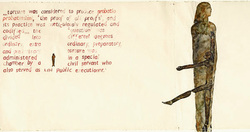
Photo credit: Nancy Spero from Torture of Women by Nancy Spero, Siglio, 2010
Finally, I enjoy all the conceptual art created by Barbara Kruger, an American artist, whose notable work includes the image below entitled 'Your Body is a Battleground'. This 1989 piece was designed for the Women's March on Washington, supporting legalised abortion, and includes a woman's face highlighted in both negative and positive exposure. The use of slogan and text overlaid on top of image infuses her work with political and popular significance, reminiscent of adverts from its contemporary age, and this style is found in her other pieces, including the witty 'I shop therefore I am'. The simplicity of the image combined with the power of her message, the dichotomy presented by the use of negative/positive exposure and the historical context of this work truly highlights the struggle for self-possession and dominion over one's self against which the modern woman battles.
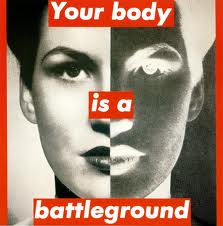
Photo credit: Barbara Kruger 'Your Body is a Battleground'
The debate over sexual representations of the female body in the media rages on, and reached fever pitch in the popular conscience last year with both Miley Cyrus' infamous VMA performance and the release of Robin Thicke's 'Blurred Lines'. Rather than shouting across the twittersphere, whether it's to champion Beyonce's lack of thigh-gap, criticise Miley's foam finger or question why Lena Dunham agreed to have Vogue retouch her cover earlier this year, let's engage with sisterhood and the meaning of feminism on a more intellectually rewarding, artistic level.
There is an astounding range of modern art imbued with feminist significance on the market today, and the hard work and originality of these women's offerings provides a counterpoint to the continual stereotypes of feminism, sexuality and gender which are splattered across the media today, and are truly worth exploring further. And if all else fails, go and watch HBO's Girls, because it's just great.

